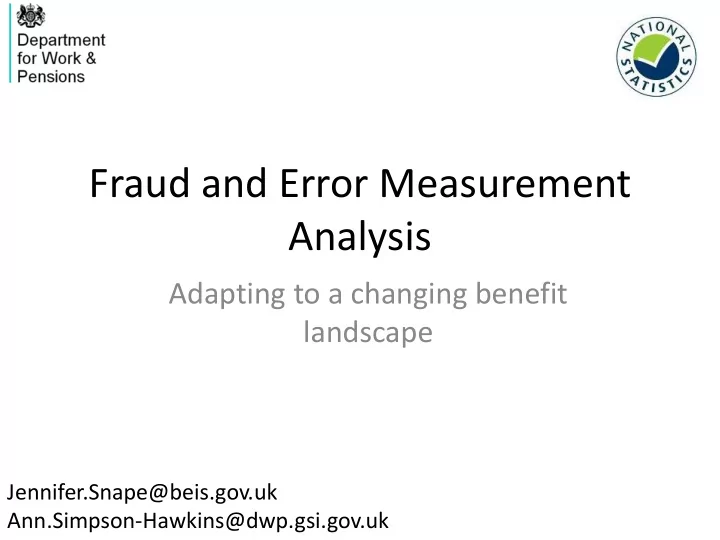

Fraud and Error Measurement Analysis Adapting to a changing benefit landscape Jennifer.Snape@beis.gov.uk Ann.Simpson-Hawkins@dwp.gsi.gov.uk
Agenda • Background • Motivation • Measurement Process • Current challenges • Solutions
Background • Estimate fraud, claimant error and official error in the benefit system • Some benefits are continuously measured : e.g. Housing Benefit, Universal Credit, Pension Credit • Some are occasionally measured : e.g. Disability Living Allowance
Quiz! How much do you know about Fraud and Error in the benefit system? Sli.do Event code #H116
Why measure Fraud and Error? • Statistics are used by: Benefit Operations, policy officials, ministers, media • Comparisons of Welfare Reform benefits (Universal Credit, PIP) to legacy benefits • Evaluate new policies or strategies to reduce fraud and error
Process for measuring fraud and Error • Take a random sample • Visit Claimants • Data input & processing • Analysis & Grossing • Publication
Challenge 1 What is Official Error, Client Error and Fraud?!
Classifying Fraud and Error • After 2014/2015 we changed how we categorised fraud and error • Resulted in an increase in fraud and a decrease in client error
Can you categorise these cases correctly as fraud, client error or official error? Sli.do Event code #H116
Challenge 2 Changes in what we measure
Changes in what we measure • Universal Credit began roll out in 2013 • We began measuring fraud and error in 2015/16 • Our first estimates were published in May 2016
Solutions! • Building up Universal Credit analysis code as it rolls out • Gradually phasing out legacy benefits – but need to keep sample numbers high enough to allow comparisons • Desk based UC reviews help increase efficiency
Challenge 3 Reduction of resources & Increasing Efficiency
Reduction of Resources • Visiting officer staff are decreasing • Uneven spread of staff across the country
Areas that can be reached in 90 minutes or less from current visiting officer locations
Reduction of Resources • Visiting officer staff are decreasing • Uneven spread of staff across the country • Large costs and reduced efficiency with longer travel times • Reduced sample sizes
Solutions! • Rotational Sampling in hard to reach areas: Cornwall, Scottish Highlands, Lake District • Desk based Housing Benefit Trial
Change 4 Complex Methodology – Sampling & Analysis
Sampling Units • Primary sampling units are Local Authorities or groups of local authorities • Complex structure • If cases have to be replaced – could be from a different part of the country !
Solutions! • Restructuring PSUs • Move to national grossing
Analysis Methodology • Analysis code is complicated ! Large amount of adjustments • Processing is clunky – Excel and SAS • Limited time between rounds to improve code.
Solutions ! • Rewrite excel spreadsheets so they can be ran in SAS • Simplifying the code, removing redundant sections.
Challenge 5 Making the Statistics more Widely Available
Solutions! • Updates to publication: new style DWP publication, updates to expressing uncertainty 12 pages 128 pages
Interactive Visualisation: appeal to wider range of users – quicker way to dig into our statistics
Any Questions? Jennifer.Snape@beis.gov.uk Ann.Simpson-Hawkins@dwp.gsi.gov.uk
Recommend
More recommend